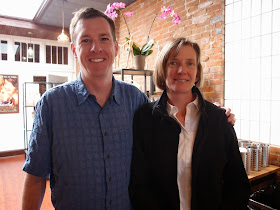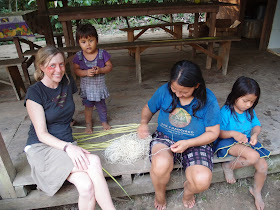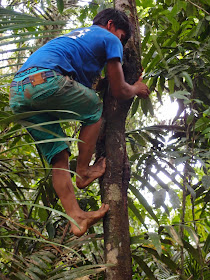
Hey all,
So I've had the grueling task of researching the goings-ons of a chocolate shop ....

I spent a glorious morning at Nuance on Pine Street in Old Town, Fort Collins. One of the settings in my novel-in-progress is a chocolate shop, and I felt the need to spend some quality time inside of one. The owners are Alix and Toby, a married couple who put their hearts into running this business. I was so grateful to Toby, who took time out of his morning (2 and a 1/2 hours!) to enthusiastically answer my many interview questions.

Toby and Alix became enchanted with chocolate-making after a trip to Costa Rica. They started making it in their home kitchen, and soon their equipment had taken over.... Their hobby bloomed into something bigger, and they decided to open a gorgeous chocolate shop!

I thought I'd give you a taste of what I learned...
The cacao pods grow on the tree trunks!
The organically-grown cacao pods are harvested at one of the small-scale, environmentally and socially respectful co-ops that they work with in Latin America or Africa. Alix and Toby try to cut out as many middlemen as possible, so that the maximum amount of money possible can go directly to the community of growers. The plantations aren't necessarily formal rectangles of land-- they can be in the middle of the jungle, which is best because the cacao plants love a good tree canopy.
There, onsite, people crack open the nerf-football sized pod and take out the beans coated with goopy stuff (mucilage) and let them sit for a few days, covered in leaves and fermenting.
This fermentation stage is essential to developing the chocolate's complex flavors and notes.
Then, after it's spread out and dried in the sunshine, the cacao is shipped in burlap or plastic or hemp sacks by boat and then by truck to Nuance, where it's roasted in Toby and Alix's own little chocolate factory here in Old Town, Fort Collins.
The beans are roasted at between 240 and 350 degrees Farenheight for about 15 to 40 minutes, in small batches. Some people use convection ovens or coffee roasters, but Nuance has their own top-secret roasting technique.... so mysterious!
Toby and Alix love experimenting with different techniques and flavors... an intriguing mix of art and science.
Machines crack the cacao beans and vacuum and winnow off the husks. So you get these cute little cacao nibs....
The cacao is then ground into chocolate that has the consistency of peanut butter. This is called chocolate liquor or cocoa mass, and it's not alcoholic, but it is thick and greasy. With exposure to air, it turns into hard chocolate chunks. This process releases aromatic and volatile compounds.
Next it goes into the melanger machine. Melanger is French for "mix." It's a big stainless steel drum, whose base and wheels are granite. For 80 hours, the stone grinds, granite against granite, mixing the cocoa mass with sugar. There's a noisy rumble as the machines mix, four of them mixing 24 hours a day, seven days a week. The goal is to get the particle size to 20 microns or less so that your tongue feels only a super-smooth texture. (Note that this is not melting with heat, but actual grinding.) In this stage the volatile acids and compounds are blown off and dissipate with exposure to air.
If the chocolate is destined to become milk chocolate, they'll add high-quality whole fat dried milk to the melanger.

Refining is the process of reducing the particle size, and conching is the process of releasing volatile compounds by stirring. So by the time the mixing is done, the sharp acidity is reduced and the flavor is more mellow.
You're left with giant chunks of chocolate, which are part of the "geology phase" of chocolate making. You can see the mottling and striated patterns in the chocolate chunk, a result of the "blooming" process. This happens because the cocoa butter parts of the chocolate crystallize at room temperature.
Then they temper the chocolate-- this is a process of controlled melting and cooling to get the structure to Beta 5, which means the cocoa butter is smoothly integrated.
To make white chocolate, they use the cocoa butter with high quality Madagascar vanilla and whole fat dried milk.
We also talked quite a bit about the horrible chemical processes that big chocolate companies use in making chocolate. It's awful, and I won't get into it here, but trust me, what the giant, soul-less businesses do to chocolate is an atrocity, and once you learn about it, you'll never want to eat cheapo, mass-produced chocolate again! Single source, bean to bar chocolate is definitely the way to go, though there are just a handful of small companies in the U.S. that produce chocolate this way. (I might tell you about all that in another post, if you're curious...)
So after Toby and Alix and their several employees make the chocolate, they form it into bars, from different countries, with different concentrations of cacao, and different cultivars of cacao (forestero, criollo, or trinitario)...

They also use some of the chocolate for hand-rolled truffles. They have fun inventing different truffle recipes, using local and artisanal ingredients from the Fort Collins area.

I was thrilled when Toby offered me this beautiful flight of chocolate after our interview!
So after Toby and Alix and their several employees make the chocolate, they form it into bars, from different countries, with different concentrations of cacao, and different cultivars of cacao (forestero, criollo, or trinitario)...

They also use some of the chocolate for hand-rolled truffles. They have fun inventing different truffle recipes, using local and artisanal ingredients from the Fort Collins area.

I was thrilled when Toby offered me this beautiful flight of chocolate after our interview!
He instructed me to eat a piece of chocolate (all in a particular order designed to maximize the tasting experience.) I was supposed to chew it a little, but also let it melt in my mouth and move it around to different parts of my mouth. After I finished each chocolate sample, I drank some water and chewed a water cracker. This process was not only delicious, and endorphin-releasing, but lots of fun!
I loved reading Toby's descriptions of each kind of chocolate and seeing if I could notice those flavors in the chocolate as I tasted. Because I love words, especially words describing taste, I'll share with you some terms used to evoke chocolate flavors: floral, fruity, nutty, metallic, earthy, woody, vanilla, oaky, coffee, strawberries, acidity/brightness, herbal, minty, astringent, tobacco...
I tasted chocolate made with beans from Ghana (rich, deep, notes of vanilla,
cherries, and honey), Ecuador (earthy, mysterious, subtle), Nicaragua
(smooth and creamy with notes of tobacco leaf, nuts, molasses),
Venezuela (beautifully balanced, notes of cashews and dairy cream), and
Madagascar (fascinating, sophisticated layers of flavor like plum and
apricot.) Not surprisingly, Toby
has a creative writing background. :-)
Also not surprisingly, he has a design background.... which leads me to the decor of Nuance... gorgeous! Their retail space is owned by my dear creator friend Les Sunde, who put a lot of effort into making it architecturally beautiful, and then, Toby and Alix beautified it further...
I really love what they did with this antique skylight, to filter the bright sunlight....
And that wraps up my blissful morning of chocolate research! Thanks for coming by...
Laura



































